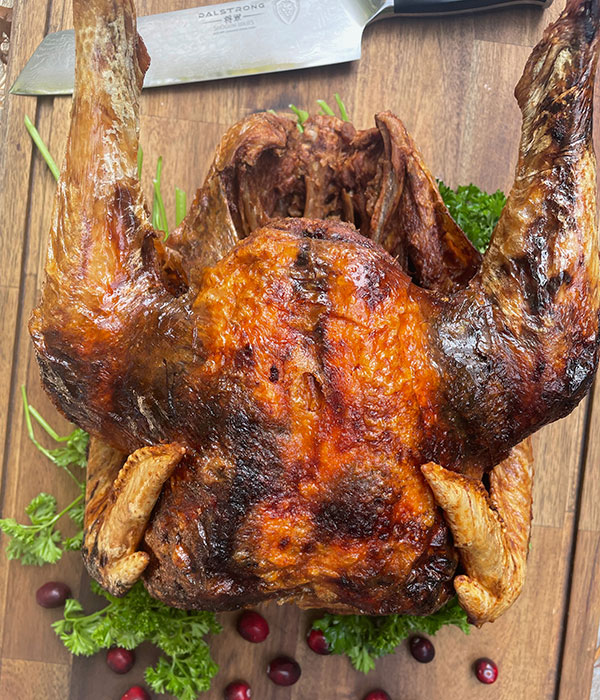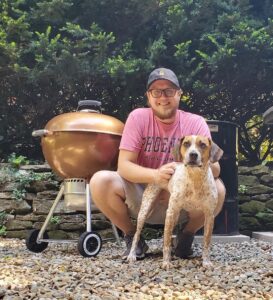How to Deep Fry a Turkey
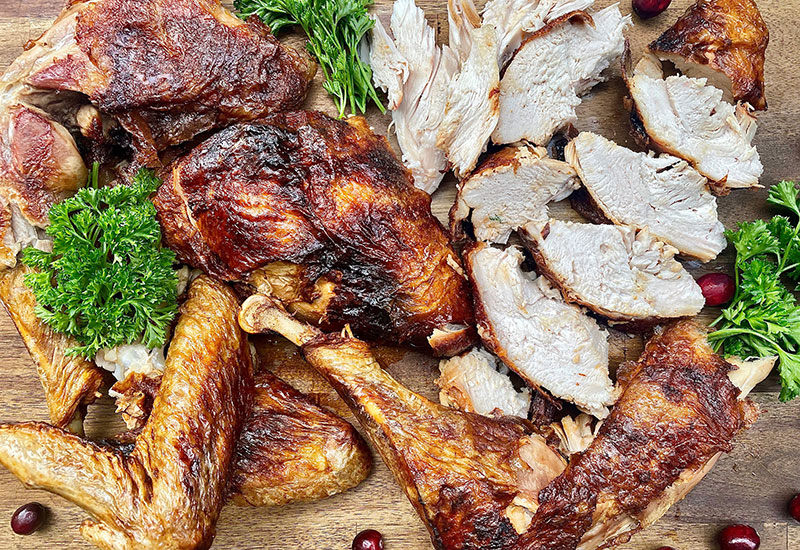
The following tutorial and photography is courtesy of Graham R. and his dog, Carl. For more of their delicious food ventures, visit them on Instagram @cookingwithcarrrl.
One of my favorite Thanksgiving pastimes is watching videos of turkey fryer explosions! You would think they are common by how often you hear about them, but the truth is, if you follow a few simple rules, you can avoid all of the dangers and be rewarded with the most crispy and juicy turkey you’ve ever had.
Thaw it Out
The best way to avoid a “turkey-splosion” is by thawing the turkey completely. I slept through most of science class, but I do know that ice and hot oil do not mix. When combined, the ice expands into gas and well, you know what happens next. If you are using a frozen turkey, make sure you allow enough time for a proper defrost. Plan on 24 hours of fridge thawing for every 4 pounds of turkey. Also, remember to remove the giblets from the cavity before frying.

Optimize the Oil
The correct amount of oil is another important step. Too little and you will not cook the entire bird, too much and you’ll have an overflow! You can measure how much oil you’ll need to fill the fryer by testing it with water first. Simply fill the pot with a couple gallons of water, then place the turkey in the fryer. If the water completely covers the bird, you are good to go and now know how much oil you’ll need.
If you choose to skip this step, plan on using at least 2 ½ – 3 gallons of oil.
While we are on the topic of oil, I should mention that peanut oil is the best oil to use when frying a turkey. It is low in saturated fat and has a very high smoke point.
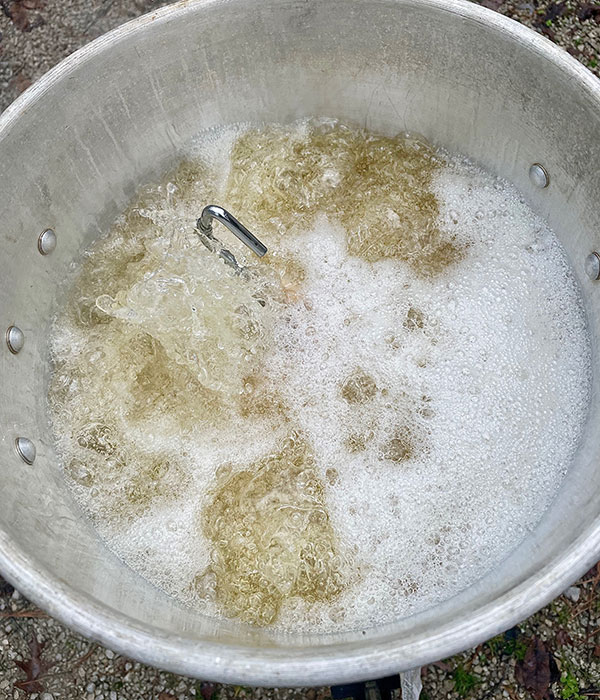
Time, Temperature and Size
One advantage of deep frying a turkey is the cook time. When roasting a turkey in the oven, you will need to budget about 13 minutes per pound, but in the fryer that number goes down to 3 1/2 minutes per pound. Time is turkey, people!
Oil temperature plays a huge role in how well your turkey will turn out. If your oil is too cold it will be absorbed by the bird and make the meat greasy. If it’s too hot, you’ll get a dry turkey and be at risk of an oil overflow. 340˚F – 375˚F is my “goldilocks zone.” You will have a tremendously juicy bird if you stay within this range.
Another variable that will affect the outcome of this deep fried adventure is the size of the turkey. I would not fry anything larger than an 18 pound bird, unless you have a jumbo deep fryer. When you fry huge birds, you run the risk of uneven cooking, which will require you to fry the bird in sections.
Brine, Inject or Season
How you prep your bird is up to you! You can brine the turkey a few days ahead of time, inject it or season it.
If you are looking for a brine recipe, be sure to check out my cranberry brine recipe. Another option for a brine is a dry brine. A dry brine is perfect for deep frying because no additional liquid is introduced. Dry brines also remove a good deal of the moisture from the skin, which results in a crispy bite.
My recommendations for frying is to inject the turkey. I choose to do this for a few reasons:
- Seasoning the outside of the bird will make the oil dirty and it won’t stick to the turkey.
- It adds the most flavor. Brines add a lot of flavor but they don’t penetrate as deep as an injection.
- Moisture. The injection penetrates deep inside the meat, ensuring a juicy bite. The injection is also a crutch from overcooking, so you will still have a juicy bird even if you cook it a bit too long!
I recommend injecting the turkey the night before you plan to fry, but it can be done as soon as one hour in advance. I’ve found that the flavor is more intense if you allow it to set overnight in the fridge.
There are a variety of injections available in stores, but I find it is much easier to make my own! You can use whatever flavors you like, but mine always have a base of chicken broth, lemon juice, maple syrup and lots of garlic. I then add whatever seasonings I am in the mood for. The general rule of thumb for a turkey injection is 0.5 ounces of injection for every 5 pounds of meat. Insert the needle into the breast and inject a small amount of the liquid. Slowly remove the needle and repeat all over the bird. My injection holes are typically 2 inches apart from one another. Slowly removing the needle will limit the amount of the injection that leaks out. You will see the turkey swell up as you inject it, and that is normal. Discard any leftover injection.
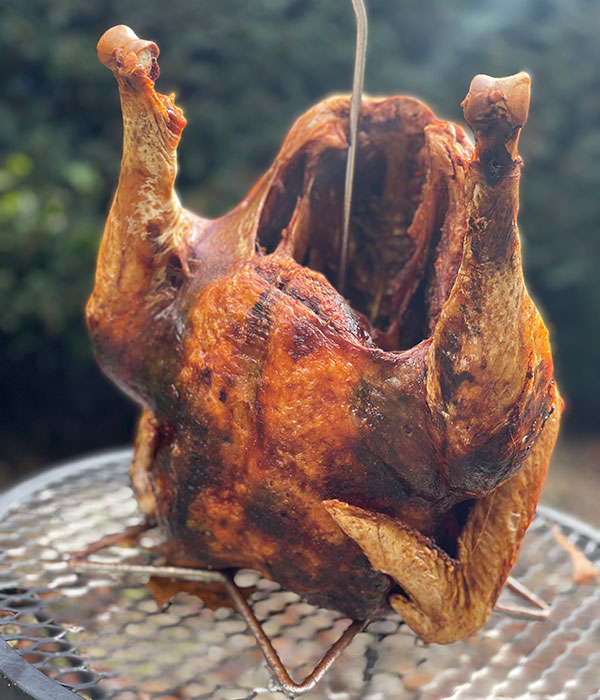
Time to Fry
When game time approaches, remove the turkey from the refrigerator. Grab a roll of paper towels and pat that turkey on the back like it won an award! Get it as dry as possible. Pat down the inside as well. Less moisture means less chance of oil splatter. I pat mine down until the paper towel has no moisture on it. This is all for that crispy skin!
Prepare the fryer and make sure the oil is at 350˚F. I always do this in a spacious area away from my house and other people. Safety first! Also, double and triple check that the propane is securely connected to the fryer. It can be easy to forget this step while you are cooking and entertaining simultaneously.
Slowly place the bird into the oil. Be careful as the hot oil will start to bubble when it meets the cold poultry. When the turkey is fully submerged, cover with a lid and set the timer.
It’s important to keep an eye on the oil temperature once the bird is in the fryer – it will drop significantly once it meets the cold poultry and you will probably need to adjust the heat to bring the oil back up to 350˚F. Keeping an eye on the temperature throughout the cooking processes very important, especially if you are using a new deep fryer or one you’re not familiar with.
When the cook time is over, carefully remove the turkey from the fryer and allow the excess oil to drain. Probe the turkey with an instant read thermometer and if it says 170˚F, you are all set. Be sure to check the drumsticks too as they tend to cook a bit slower than the rest of the bird. Frying usually cooks the entire bird evenly, but I always double check. Allow the turkey to rest for 30 minutes before slicing. Enjoy!
After you’re finished tripping on tryptophan, you can bottle up the oil and use for additional fried recipes.
